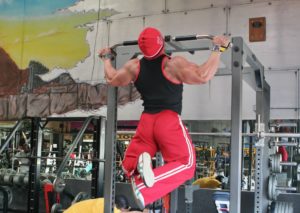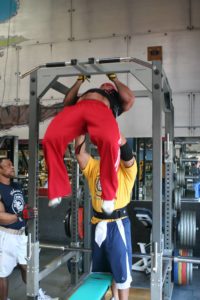
How varying your grip in these powerful exercises helps you achieve your training goals
By Strength Sensei CP
Publication Date: 2004
Nautilus founder Arthur Jones called his pullover machine “The Upper Body Squat” for its ability to directly work the lats. While I like Jones’ machine, chin-ups and pull-ups give you more bang for your buck.
To be clear, you perform a chin-up with a supinated grip (palms facing you) and a pull-up with a pronated grip (palms facing away from you). During these exercises, the muscle groups worked include the abs, elbow flexors, lats, lower traps, posterior delts, rhomboids, and the sternal portion of the pec major.
Any sport that requires upper-body pulling strength, such as judo and wrestling, will benefit from chin-ups and pull-ups. The upper back development of male gymnasts who excel in the still rings is a testament to the value of these exercises.
The position of the hands influences what muscle groups are emphasized in chin-ups. Research from a 2002 study by Joseph Signorile and others on the lat pulldown foundthat performing this exercise with a wide grip produces greater muscle activity in the lats than any other grip position.
Although these researchers did not verify this data of the various forms of pull-ups/chin-ups, one can suspect that the results would be similar. Earlier research also demonstrated that the width of the grip might also influence the portion of the lats most affected. As a rule of thumb, the wider the grip, the more superior and anterior fibers are recruited. Conversely, narrower grips tend to recruit more the lower fibers referred to as the illiacus portion of the lats.
 Changing the hand position in pull-ups enables bodybuilders to “sculpt” their physique to achieve balanced development. Miloš Šarčev photo.
Changing the hand position in pull-ups enables bodybuilders to “sculpt” their physique to achieve balanced development. Miloš Šarčev photo.
The researchers also did not verify the effect of the different grips of the elbow flexors. Based on experience and logical deduction from kinesiology manuals, the brachialis, brachioradialis, and pronator teres would be more recruited by pronated grips. In contrast, the supinated grips would bring about greater recruitment of the biceps brachii. Empirically speaking, this can also be verified by the specificity of strength gains.
I had a client, a National Team Judoka, who on the first day training with me could perform six perfect reps on the shoulder-width supinated grip chin-ups with 90 pounds tied to his waist at a bodyweight of 182 pounds. And yet, he could only complete three wide grip pull-ups. Obviously, he had failed to train all the motor unit pool of the latissimus dorsi.
The key point to remember is that it is to your advantage in developing your back to vary your grip periodically to maximize the recruitment of all the available motor unit pool.
